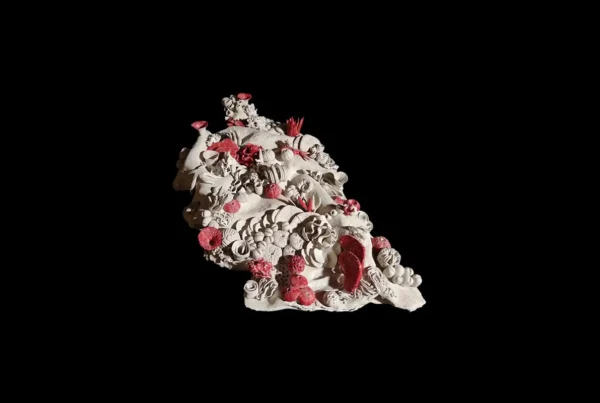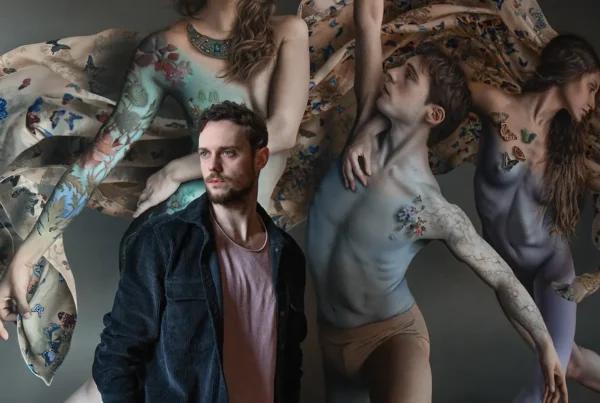Nature’s Muse: The Early Influences of Saype
Saype, born Guillaume Legros near the tranquil French-Swiss border, draws a profound connection between his upbringing and his artistic evolution. Growing up in Évette-Salbert, he was enveloped by the serene landscapes that surrounded his home. The rolling hills, the ever-changing colors of the seasons, and the deep tranquility of nature became the fertile ground from which his creativity would eventually blossom. This early immersion in nature didn’t just inspire Saype; it ingrained in him a deep respect for the environment, which would later become a cornerstone of his artistic philosophy. Despite initially pursuing a career as a nurse, the experiences and existential questions he encountered during this time only further fueled his desire to create art that speaks to both the beauty and fragility of life.
The intersection of nature and human experience is evident in Saype’s work. His time in nursing exposed him to the raw realities of human suffering and the delicate balance of life, which deeply influenced his artistic vision. This period of his life instilled in him a sense of urgency to address the fleeting nature of existence, leading him to create works that not only highlight the beauty of the world but also encourage viewers to reflect on their own lives. This duality—between the eternal and the ephemeral, the natural and the human—forms the bedrock of Saype’s unique artistic voice.
As Saype’s journey into art began with graffiti, he quickly recognized that traditional forms of street art, while powerful, were becoming less impactful in their ubiquity. He sought something more profound, a way to engage with the world on a larger scale, both literally and figuratively. His transition from graffiti to land art was driven by a desire to create something that resonated deeply with both the individual and the collective, leading to his exploration of large-scale, biodegradable art that could speak to the impermanence of all things.

Saype: From Street Corners to Sweeping Landscapes
The leap from graffiti artist to land art pioneer was not just a change in medium but a complete transformation in Saype’s approach to art. Beginning with graffiti at fourteen, Saype found an early outlet for his creative expression. However, as graffiti became more mainstream, he felt its impact waning. This realization led him to search for a new way to communicate his ideas, one that would captivate and provoke thought on a much grander scale. The advent of drone technology in 2012 provided Saype with the perfect tool to expand his artistic vision. Aerial views offered by drones allowed him to imagine artworks on an unprecedented scale, visible only from above, and thus began his journey into land art.
Saype’s innovation didn’t stop at scale. Understanding the environmental implications of his work, he devoted considerable effort to developing a 100% biodegradable paint. Composed of water, chalk, charcoal, and casein, this eco-friendly paint reflects his commitment to creating art that exists in harmony with nature. His land art, often spanning vast natural landscapes, is designed to fade away naturally over time, symbolizing the transient nature of life itself. Each piece is a fleeting moment of beauty, destined to disappear as nature reclaims it, reinforcing the idea that all things, including art, are temporary.
This shift from permanent graffiti to ephemeral land art marks a profound evolution in Saype’s artistic philosophy. No longer content with static, unchanging works, he embraced the dynamic interplay between creation and dissolution. This philosophy of impermanence is not just a thematic choice but a driving force in his work, compelling viewers to confront the fleeting nature of existence and the impermanence of all things. By doing so, Saype’s art becomes a meditation on time, life, and the delicate balance we must maintain with the world around us.

The Ephemeral Nature of Art and Life
Central to Saype’s artistic vision is the concept of impermanence, a theme that permeates all his work. His art is designed to exist only temporarily, a conscious decision that mirrors the transient nature of life itself. Each piece, created on a vast scale and often in remote natural landscapes, is meant to be admired for a brief period before it fades away, leaving no trace. This deliberate ephemerality challenges traditional notions of art as something to be preserved and cherished indefinitely. Instead, Saype’s work invites viewers to appreciate the beauty of the moment and reflect on the impermanence of all things.
This focus on impermanence is also a commentary on the human experience. By creating artworks that are destined to disappear, Saype encourages his audience to consider their own lives in a new light. His pieces act as a reminder that life is fleeting, and that each moment should be lived with intention and awareness. The natural decay of his artworks, as they are slowly reclaimed by the environment, serves as a powerful metaphor for the cycle of life and death, underscoring the importance of living in harmony with the natural world.
The use of biodegradable materials in his work is another layer to this message. Saype’s commitment to environmental sustainability is evident in every piece he creates. By ensuring that his art leaves no lasting impact on the landscape, he emphasizes the need for humanity to tread lightly on the earth. His work is a call to action, urging people to consider the environmental consequences of their actions and to strive for a more sustainable and harmonious relationship with the planet. Through his art, Saype not only explores the theme of impermanence but also advocates for a more responsible and mindful way of living.

Saype: Uniting Humanity Through “Beyond Walls”
One of Saype’s most ambitious and impactful projects to date is the “Beyond Walls” series, a global art initiative that seeks to foster unity and solidarity across cultures and nations. This project, born out of Saype’s deep conviction that humanity must come together to overcome the challenges of our time, involves creating a series of interconnected hands painted across cities around the world. Each pair of hands symbolizes connection, support, and mutual respect, forming what is intended to be the largest human chain ever created. Through this visual language, Saype aims to transcend borders and cultural differences, promoting a message of unity in an increasingly divided world.
The “Beyond Walls” project began in 2019 at the foot of the Eiffel Tower in Paris and has since expanded to over 19 cities globally, including major urban centers such as New York, Cape Town, and Venice. Each location is chosen for its unique social and historical significance, with the artworks tailored to resonate with the local community while also contributing to the overarching global theme. Saype’s work in these cities not only draws attention to the need for unity but also engages with the specific cultural and historical narratives of each place, making the project both globally relevant and locally meaningful.
The impact of “Beyond Walls” has been profound, reaching millions of people through both direct engagement and global media coverage. The project has sparked conversations about the importance of solidarity and collective action, resonating deeply in a world where division and polarization are increasingly prevalent. For Saype, the success of “Beyond Walls” is a testament to the power of art to bring people together, inspire change, and foster a sense of global community. As he continues to expand the project to new locations, Saype remains committed to using his art as a force for positive change, encouraging people to look beyond their differences and work together for a better future.






